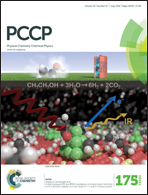Saccharide-induced modulation of photoluminescence lifetime in microgels†
Abstract
Sugar-responsive microgels were prepared by the covalent grafting of a poly(N-isopropylacrylamide) (pNIPAM) matrix with phenylboronic acid (PBA) as a saccharide sensing unit and a [Ru(bpy)3]2+ derivative (2,2′-bipyridine) as a luminescent reporter. Time-resolved emission studies reveal that the ruthenium complex has an unusually long lifetime (1.6 μs) and high quantum yield (∼0.17) in the PBA-microgel environment. In the presence of sugars, the microgels swell due to the formation of a sugar–boronate ester, leading to a more hydrophilic polymer chain. The swelling is accompanied by a decrease of the lifetime and the photoluminescence quantum yield, which cannot be explained solely by the swelling of the hydrogel. The emission properties of the ruthenium complex in PBA-functionalized microgels are compared to those in pNIPAM microgels lacking PBA moieties in various swelling states. The presence of PBA in the vicinity of [Ru(bpy)3]2+ is shown to have a predominant impact on its luminescence properties, mainly through a decrease of the polarity. Sugar-induced triggering of the boronate state thus leads to strong variations of the polarity and the luminescence characteristics.



 Please wait while we load your content...
Please wait while we load your content...